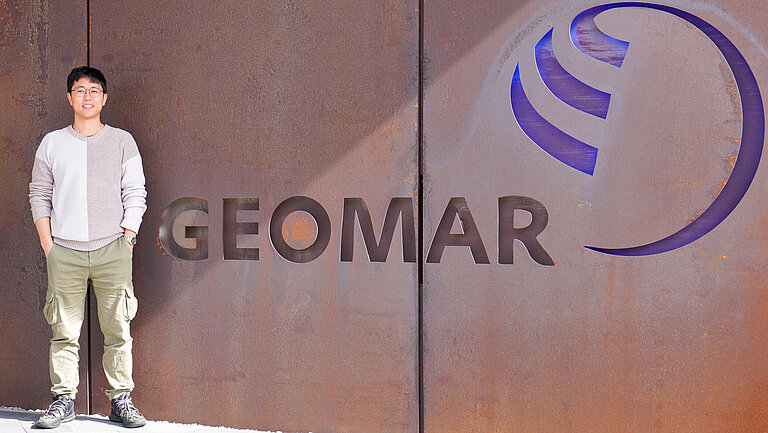How do Bubbles contribute to Gas Exchange between Air and Sea?
Humboldt Fellow Dr Yuanxu Dong enriches Chemical Oceanography at GEOMAR
The Alexander von Humboldt Foundation promotes scientific collaboration between foreign and German researchers through its research fellowships. This funding enables outstanding postdoctoral researchers from abroad to work on their projects at German research institutions. This year, the GEOMAR Helmholtz Centre for Ocean Research Kiel welcomed a new fellow: Dr. Yuanxu Dong will be hosted by Dr. Christa Marandino in the Chemical Oceanography research unit for two years.
Originally from China, Dr Yuanxu Dong's most recent academic stint was in Norwich, England, where he earned his doctorate at the University of East Anglia. Ideally, the newly minted oceanographer Dr Yuanxu Dong would have set sail immediately afterward with his current co-host: Dr Christa Marandino, Senior Lecturer and Head of the Air-Sea Gas Exchange Research Group at GEOMAR, served as expedition leader on a five-week voyage to the Labrador Sea last December. During this winter expedition, she investigated the contribution of bubbles to gas exchange between the atmosphere and the ocean. This very topic is what Dr Yuanxu has chosen for his postdoctoral research project at GEOMAR.
“I am interested in the global air-sea CO2 flux,” he says. While it is known that the ocean absorbs a significant portion of CO2 emissions, the role of bubbles in this process remains a mystery.
His host, Dr Marandino, outlines the challenge: “Quantification is often done mathematically, based on laboratory data. Laboratory studies are useful to understand mechanisms, but the laboratory is not a real ocean environment.” However, field observations of the bubble-mediated transfer are challenging because of the rough sea state at very high wind speeds and with wave breaking. It's not surprising that there are still no measurement data for gas exchange under storm conditions, i.e., at high wind speeds of 20 to 30 meters per second (approximately 70 to 100 kilometres per hour). However, the number of storms is expected to increase due to climate change, making it increasingly important to understand the role of bubbles in air-sea gas exchange.
Recently, Dr Yuanxu Dong published a significant study in the renowned journal Science Advances. Together with an international team, he demonstrated that the Southern Ocean surrounding Antarctica absorbs around 25 per cent more carbon dioxide than previously thought. This new study employed a high-precision measurement method called “eddy covariance,” which measures the movement of atmospheric eddies to calculate the net gas flow by computing the correlation of the vertical wind speed and gas concentration fluctuations. This allows for the direct determination of CO2 exchange between the ocean and the atmosphere. Data was collected using this method during seven research cruises in the Southern Ocean. The results represent a significant advance in understanding the role of this ocean in regulating the global climate, although winter data is still lacking.
Since the summer, Dr. Yuanxu Dong has been involved in the innovative design and construction of a CO₂ eddy covariance system for deployment on a buoy as part of the MUSE research project (Marine Environmental Robotics and Sensors for Sustainable Research and Management of Coasts, Seas, and Polar Regions). This rare type of installation has the potential to significantly enhance our direct measurements of CO₂ flux between the air and sea, expanding our understanding of air-sea exchange processes.
In March and September, he has been hosted by his co-host Prof. Dr Bernd Jähne at the Institute of Environmental Physics at Heidelberg University. In the Aeolotron facility there, one of the largest and most modern annular wind-wave channels in the world, he conducted experiments on bubble-mediated transfer processes. He will now cross-link these laboratory results with the data from his field experiments to understand the mechanisms of the bubble-mediated gas exchange.
Just in time for the start of the dark season, Dr Yuanxu is back in Kiel. However, he is not afraid of the northern German winter: “I survived Norwich, and Kiel is only slightly further north,” he says with a hearty laugh.
Original publication:
Yuanxu Dong et al. (2024): Direct observational evidence of strong CO2 uptake in the Southern Ocean. Sci. Adv.10.
DOI:10.1126/sciadv.adn5781

Breaking waves blow bubbles into the water. Directly measuring their contribution to the exchange of CO2 between the ocean and the atmosphere is a challenge. Photo: Adobe Stock

Dr Yuanxu Dong enriches the work of the Chemical Oceanography Research Unit at GEOMAR as a Humboldt Fellow for two years. Photo: Ilka Thomsen, GEOMAR


